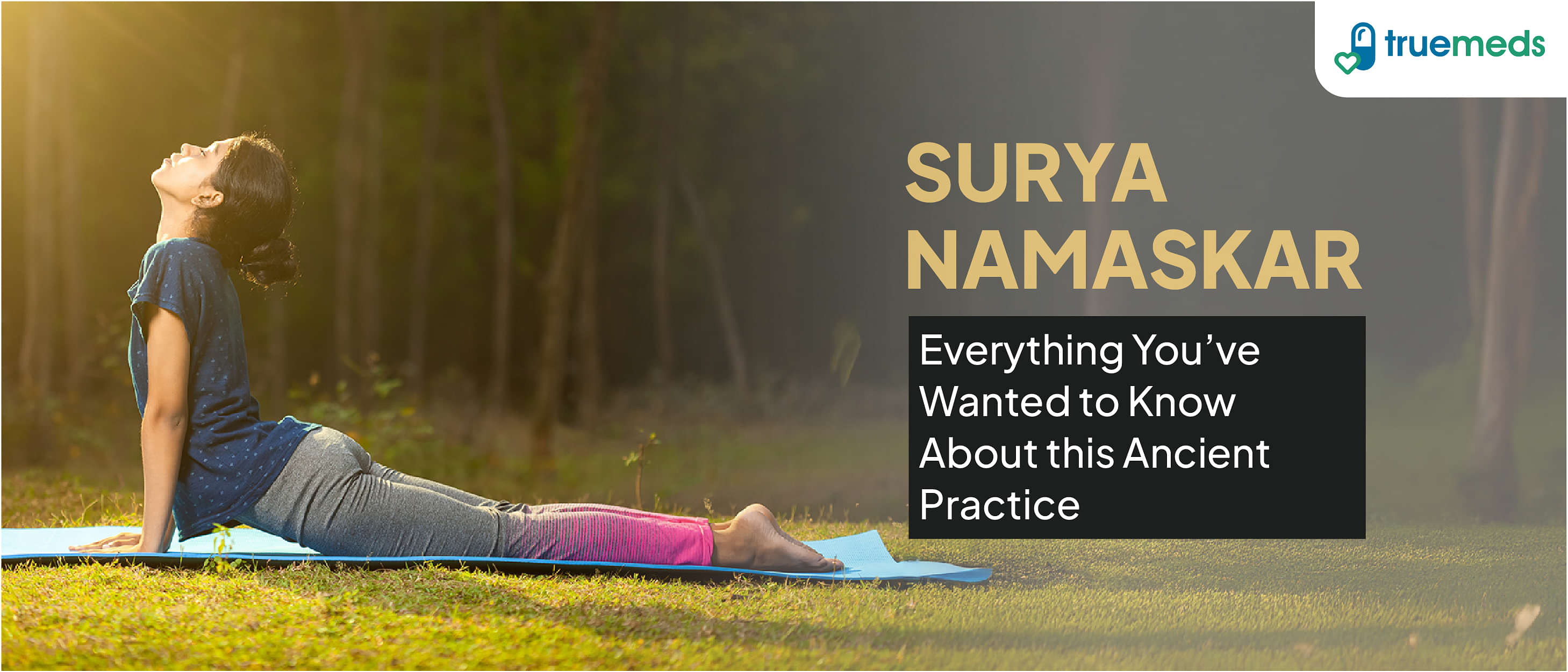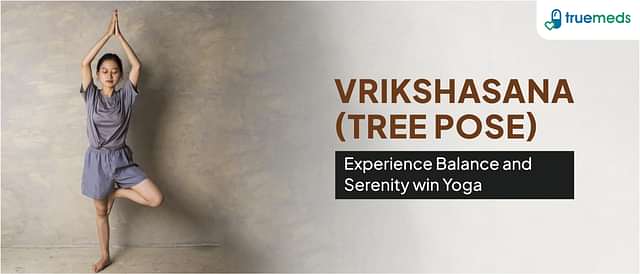Surya Namaskar: Benefits, Steps, and How To Do It
Last updated on : 18 Mar, 2025
Read time : 12 min
Surya Namaskar, or Sun Salutation, is a time-honoured yoga practice that has been an integral part of yogic traditions for centuries. This dynamic sequence of poses is a powerful tool for enhancing physical, mental, and spiritual well-being. By incorporating Surya Namaskar into your daily routine, you can experience a wide range of benefits that contribute to overall health and vitality.
What is Surya Namaskar?
Surya Namaskar is a series of 12 yoga poses performed in a flowing sequence, synchronised with the breath. This comprehensive practice serves as a full-body workout, engaging and stretching various muscle groups while stimulating the cardiovascular and nervous systems. Each cycle of Surya Namaskar consists of two sets of 12 poses, ideally performed in the morning on an empty stomach, facing the rising sun. The practice is revered for its ability to promote physical strength, flexibility, and mental clarity.
| Did You Know: Surya Namaskar has a rich history rooted in ancient Indian traditions. Originally a series of twelve yoga poses performed in a flowing sequence, it was designed to honour Surya, the Hindu sun deity. References to Surya worship date back thousands of years in India, and Surya Namaskar became a symbolic expression of gratitude, health, and vitality. In the early 20th century, the Maharaja of Aundh, Bhawanrao Pant Pratinidhi, popularised Surya Namaskar as a morning exercise routine, bringing it into the modern fitness world. |
The 12 Steps of Surya Namaskar
The following 12 steps, when performed in sequence, form the complete Surya Namaskar or Sun Salutation.
- Pranamasana (Prayer Pose)
- Hastauttanasana (Raised Arm Pose)
- Hastapadasana (Standing Forward Bend)
- Ashwa Sanchalanasana (Equestrian Pose)—Right Side
- Dandasana (Stick Pose)
- Ashtanga Namaskara (Eight Limbed Pose)
- Bhujangasana (Cobra Pose)
- Adho Mukha Svanasana (Downward Facing Dog Pose)
- Ashwa Sanchalanasana (Equestrian Pose)—Left Side
- Hastapadasana (Standing Forward Bend)—Second Side
- Hastauttanasana (Raised Arm Pose) – Second Side
- Tadasana (Mountain Pose)
How to Perform Surya Namaskar: Step-by-Step
Surya Namaskar is a dynamic yoga sequence that combines 12 poses, synchronised with the breath, to create a flowing practice that energises and rejuvenates the body and mind. Here is a detailed, step-by-step guide on how to perform Surya Namaskar:
Step 1: Pranamasana (Prayer Pose)
- Stand at the edge of your yoga mat with your feet together.
- Distribute your weight evenly on both feet, expand your chest, and relax your shoulders.
- Inhale and lift both arms up from the sides. As you exhale, bring your palms together in front of your chest in a prayer position.
- Optional mantra: “Om Mitraaya Namaha”.
Step 2: Hastauttanasana (Raised Arm Pose)
- Remain standing tall.
- Inhale and lift your arms up and back, keeping your biceps close to your ears.
- Stretch your entire body from the heels to the fingertips.
- Tip: Gently push your pelvis forward to deepen the stretch.
Step 3: Hastapadasana (Standing Forward Bend)
- From the raised arm pose, exhale and bend forward from the waist.
- Keep your spine long as you bring your hands down to the floor beside your feet.
- Tip: If needed, bend your knees slightly to bring your palms to the floor. Then, try to straighten your knees while keeping your hands in place.
Step 4: Ashwa Sanchalanasana (Equestrian Pose)—Right Side
- Inhale and step your right leg back as far as possible.
- Bring your right knee to the floor and look up, ensuring your left foot is between your palms.
- Keep your spine long and your chest open.
Step 5: Dandasana (Stick Pose)
- Inhale and step your left leg back to join your right leg.
- Align your body in a straight line from head to heels, keeping your arms perpendicular to the floor.
- Engage your core and maintain a steady plank position.
Step 6: Ashtanga Namaskara (Eight Limbed Pose)
- Exhale and gently lower your knees to the floor.
- Take your hips back slightly, then slide forward, bringing your chest and chin to the floor.
- Keep your elbows close to your body and your posterior abdomen slightly off the floor.
Step 7: Bhujangasana (Cobra Pose)
- Inhale and slide forward, gradually straightening your arms to lift your chest off the floor.
- Keep your shoulders relaxed and away from your ears, engaging your back muscles to hold the pose.
- Keep your legs engaged and the tops of your feet pressed into the mat.
Step 8: Adho Mukha Svanasana (Downward Facing Dog Pose)
- Exhale and lift your hips up and back, forming an inverted ‘V’ shape with your body.
- Press your palms and heels into the mat, lengthening your spine and tailbone.
- Keep your head between your arms, and your shoulders relaxed.
Step 9: Ashwa Sanchalanasana (Equestrian Pose)—Left Side
- Inhale and step your left foot forward between your hands.
- Lower your right knee to the floor and look up, keeping your spine long and chest open.
Step 10: Hastapadasana (Standing Forward Bend)—Second Side
- Exhale and step your right foot forward to meet your left foot.
- Bend forward from the waist, keeping your spine long as you bring your palms to the floor.
Step 11: Hastauttanasana (Raised Arm Pose)—Second Side
- Inhale and lift your arms up and back, stretching your body from heels to fingertips.
- Gently arch your back, keeping your arms close to your ears.
Step 12: Tadasana (Mountain Pose)
- Exhale and lower your arms to your sides, returning to a standing position.
- Keep your feet together, balance your weight evenly, and maintain a tall, steady posture.
Also Read : Ashtanga Yoga: Its Benefits, Types & Steps
Benefits of Surya Namaskar
Incorporating the Surya Namaskar into your daily routine can lead to significant improvements in your physical health, mental well-being, and overall quality of life.
1. Physical Benefits
Surya Namaskar is a full-body workout that engages multiple muscle groups and joints, leading to several physical benefits:
- Improves Flexibility and Strength: The sequence includes a variety of stretches and poses that target the hamstrings, shoulders, arms, back, and other muscle groups, helping to increase flexibility and build strength.
- Enhances Blood Circulation and Cardiovascular Health: Regular practice of Surya Namaskar improves blood flow throughout the body, ensuring that oxygen and nutrients reach all organs and tissues. This, in turn, supports cardiovascular health by reducing the risk of blood pressure issues and keeping the heart strong.
- Boosts Metabolism and Aids in Weight Management: As a holistic exercise, Surya Namaskar burns calories, boosts metabolism, and improves digestion, which can help in shedding excess weight and maintaining a healthy body composition when combined with a balanced diet.
- Tones Muscles and Improves Joint Mobility: The sequence includes poses that effectively tone the arms, abs, and leg muscles. Moreover, Surya Namaskar enhances the mobility of nearly all joints in the body, as demonstrated by kinematics studies.
2. Physiological Benefits
Surya Namaskar’s impact on the body extends beyond the musculoskeletal system, positively influencing various internal organs and bodily functions:
- Stimulates Internal Organs and Improves Digestion: The alternating stretching and compression of the abdominal area during Surya Namaskar stimulates the stomach and other abdominal organs, promoting better peristalsis of the intestines. This leads to enhanced digestion and a reduced likelihood of digestive issues like bloating or constipation.
- Enhances Respiratory Function: The specific breathing pattern followed during each movement of Surya Namaskar helps to improve lung capacity and the overall efficiency of the respiratory system. Increased oxygen intake supports the body’s functions and promotes respiratory health.
- Detoxifies the Body: By stimulating various systems, including the lymphatic system, Surya Namaskar aids in removing toxins from the body. Additionally, the sweating that occurs during practice helps to eliminate waste and toxins, leaving the body feeling refreshed and energised.
3. Psychological and Mental Benefits
The practice of Surya Namaskar extends its benefits to the realm of mental health, promoting a sense of calm, focus, and overall well-being:
- Reduces Stress and Anxiety: The flowing movements and synchronised breathing in Surya Namaskar act as a moving meditation, providing a respite from mental stress and anxiety. Regular practice helps in achieving a meditative state, fostering mental clarity and focus.
- Improves Mental Focus and Concentration: Each pose in the sequence demands attention and focus, keeping the practitioner fully engaged. This mental workout enhances concentration and mental clarity, which can be beneficial in daily tasks, studies, or work.
- Enhances Overall Well-Being and Energy: By engaging the body and breath, improving circulation, and stimulating various bodily systems, Surya Namaskar boosts energy levels. This energy boost can last throughout the day, contributing to a general sense of well-being.
4. Spiritual and Holistic Benefits
Surya Namaskar is more than just a physical practice; it is a means to connect with the divine and cultivate inner awareness:
- Syncs with Solar Cycle and Enhances Receptivity: Practicing Surya Namaskar helps in synchronising the body’s cycles with the solar cycle, promoting balance and receptivity. This alignment is believed to help in breaking free from compulsive cycles and fostering a deeper connection with the self and the universe.
- Cultivates Mindfulness and Self-Awareness: The mindful execution of each pose and the focus on breath during Surya Namaskar encourages practitioners to be present in the moment. This heightened awareness can lead to a better understanding of oneself and promote personal growth.
- Promotes a Sense of Gratitude and Reverence: As a salutation to the sun, which is considered a symbol of life and vitality, Surya Namaskar instills a sense of gratitude and reverence for the natural world. This appreciation can extend to other aspects of life, fostering a positive outlook and a deeper sense of purpose.
Tips for Beginners Practicing Surya Namaskar
For those new to yoga, starting with Surya Namaskar can be both rewarding and challenging. Here are some tips and pointers to help beginners navigate this powerful sequence of yoga poses:
- It is recommended to practice Surya Namaskar in the morning on an empty stomach to maximise its benefits.
- Begin with some light stretching or simple yoga poses to warm up your muscles. This helps in preventing injuries and makes the practice more comfortable.
- Practice Surya Namaskar on an empty stomach to ensure you get the full benefits and to avoid any discomfort during the practice.
Common Mistakes to Avoid
- Do not force your body beyond its limits. If you feel any pain or discomfort, stop immediately.
- Ensure you are breathing correctly with each pose. Inhale during stretches and exhale during folds.
Modifications for Different Needs
- Avoid bending backward in Hastauttanasana if you have back pain. Instead, raise the arms up keeping the torso erect.
- Bend your knees in Hastapadasana if you have tight hamstrings, allowing your hands to reach the floor comfortably.
By keeping these tips in mind, beginners can safely and effectively practice Surya Namaskar, reaping its numerous benefits. As you continue your practice, you will find yourself becoming more comfortable with each pose and the overall sequence.
In summary, Surya Namaskar is a powerful and revitalising sequence of yoga poses that offers a wide range of physical, mental, and spiritual benefits. By understanding the proper techniques, breathing patterns, and modifications, beginners can safely incorporate this practice into their daily routine. With regular practice, Surya Namaskar can help improve flexibility, strength, balance, and overall well-being, making it a valuable addition to any yoga practice or fitness regimen.
Frequently Asked Questions (FAQs)
Beginners should start with 5-10 rounds of Surya Namaskar daily, gradually increasing as fitness improves. Advanced practitioners can perform 15-25 rounds or more.
Performing 20 Surya Namaskars daily can burn 260-340 calories, improve muscle tone, increase blood circulation, and enhance mental clarity and endurance.
While Surya Namaskar can aid in weight loss, losing 10 kg requires a comprehensive plan that includes a balanced diet and other forms of exercise.
Yes, 12 rounds of Surya Namaskar can burn around 416 calories and provide significant benefits, but consistency and balance with other health practices are crucial.
As part of a broader weight loss plan that includes diet and other exercises, Surya Namaskar can help reduce belly fat by increasing metabolism and burning calories.
Surya Namaskar offers more physiological benefits than walking, including improved circulation, respiratory function, and muscle utilisation, making it a more comprehensive workout.
Individuals with certain medical conditions should consult their doctor before practicing Surya Namaskar. It is also advisable to practice under the supervision of a certified yoga instructor.
While Surya Namaskar is best done in the morning to align with the sun’s cycles, it can also be performed in the evening as part of a nightly routine.
The best time for Surya Namaskar is at sunrise, as it aligns with the solar cycle and helps revitalise the body and mind. However, it can be done at other times based on personal preference and schedule.
References
- https://pmc.ncbi.nlm.nih.gov/articles/PMC8814407#:~:text=The%20effects%20of%20Suryanamaskar%20performed,to%20Yoga%20training%20%5B13%5D.
- https://www.researchgate.net/publication/331277345_A_Comprehensive_Study_On_Effect_Of_Surya_Namaskar_On_Cardio-respiratory_Endurance
- https://pmc.ncbi.nlm.nih.gov/articles/PMC3193657/
- https://www.sciencedirect.com/science/article/abs/pii/S1744388122001591
- https://ijcrt.org/papers/IJCRT2211151.pdf
Disclaimer
Our healthcare experts have carefully reviewed and compiled the information presented here to ensure accuracy and trustworthiness. It is important to note that this information serves as a general overview of the topic and is for informational purposes only. It is not intended to diagnose, prevent, or cure any health problem. This page does not establish a doctor-patient relationship, nor does it replace the advice or consultation of a registered medical practitioner. We recommend seeking guidance from your registered medical practitioner for any questions or concerns regarding your medical condition.
Popular Articles
Recommended Articles
Recent Articles
Top-Selling Medicines:
...View more
Top-Selling OTC:
...View more
Company
About UsHealth ArticleHealth StoriesDiseases & Health ConditionsAll MedicinesAll BrandsNeed HelpFAQSubscribe
Registered Office Address
Grievance Officer
Download Truemeds

Contact Us
Our customer representative team is available 7 days a week from 9 am - 9 pm.
v3.7.8
Our Payment Partners



























































